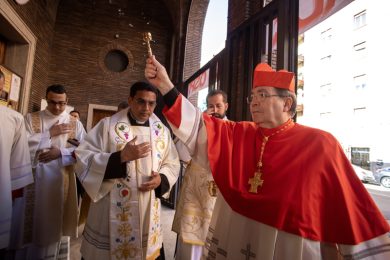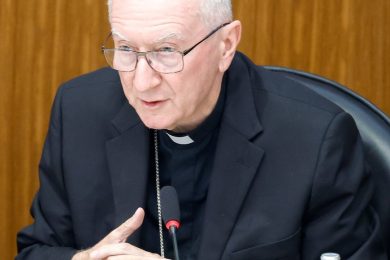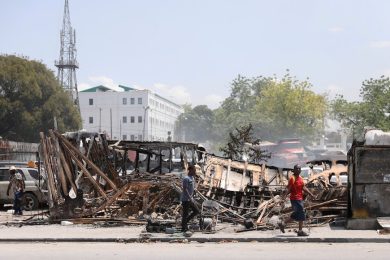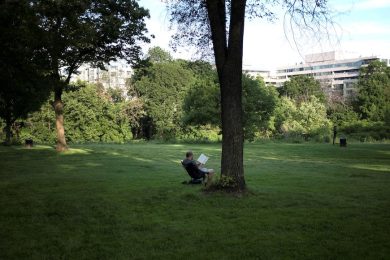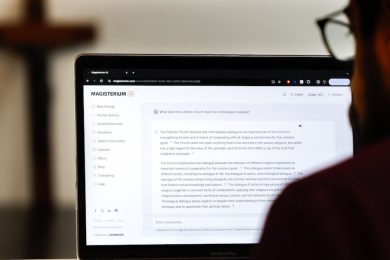ST. PAUL, Minn. (CNS) — On March 20, as Minnesota residents prepared to follow Gov. Tim Walz’s stay-at-home order to curb the spread of COVID-19, men studying for the priesthood at St. Paul Seminary in St. Paul embarked on an opportunity: Instead of returning home, they began a “cloister” at the seminary.
While many major seminaries in other parts of the country chose to send their seminarians home, Father Joseph Taphorn, seminary rector and vice president, met with his leadership team and decided to keep the facility open to its graduate-level seminarians. It would operate in a cloistered environment, with little direct contact with the outside world.
The decision took effect the weekend before spring break.
“It made the most sense to me because this is home,” Father Taphorn said. The vast majority of the seminarians live at the seminary, where they also worship and take classes.
“We might as well do it together (rather) than scatter to the four winds,” he said. “Let’s continue the work we were doing.”
Seminary leadership gave the men and their bishops a choice to stay or go home. “Rather than say ‘everybody has to do this,’ we phrased it like an invitation: If you would like to … ride out the storm together, this is what it will look like. And we’d love to have you stay together and be part of it,” Father Taphorn told The Catholic Spirit, newspaper of the Archdiocese of St. Paul and Minneapolis.

One diocese asked its three seminarians to return home, and another seminarian from a second diocese also left. Four Pro Ecclesia Sancta brothers and deacons, as well as one other seminarian, already lived off-site.
The other 59 seminarians decided to stay. This includes St. Cloud seminarians Deacons Thomas Skaja, Patrick Hoeft and Brady Keller, who are preparing to be ordained to the priesthood next month, as well as Kevin Soenneker and Daniel Ruprecht. Twelve priests also are living at the seminary, including spiritual and formation directors and Father Taphorn.
There have been challenges under the unique circumstances, but it also has borne great fruit and offered opportunities for growth, several seminarians said.
At first it seemed daunting to live so close with others, with no chance to break away by going to a restaurant or a movie, said Jason Lee of St. Boniface Parish in Waukee, Iowa.
“But that also allows friendships to become closer,” Lee said. “A lot of guys play board games or go for walks together or bike rides, so it’s a great opportunity for fraternity and solidarity.”
The special fraternity developing among the seminarians will impact their future ministries, said Kyle Etzel of St. Hubert Parish in Chanhassen, Minnesota.
“Once we’re ordained and have the kinds of bonds that we’re developing in this sort of pressure-cooker situation, I think it’s going to pay off, he said. “Fraternity within a seminary is something every seminarian hopes for and every rector is trying to accomplish.”
The faithful will benefit, too, Etzel said, when their priests know each other well and can have a good, holy, healthy fraternity. “I think that’s the single biggest thing that’s going to come out of this.”
The cloister experience also has presented the seminarians with an opportunity to take a hard look at their interior lives, said seminarian John Rumpza of Nativity of Our Lord Parish in St. Paul, referring to what C.S. Lewis called “a severe mercy.”
“It’s given me the opportunity to spend time with the Lord and show him those places … and actually bring healing, joy and peace,” he said. It’s difficult but powerful work, Rumpza said, and it has profoundly changed him.
The seminarians had high praise for Father Taphorn. “It’s been inspiring to watch him lead us,” Rumpza said, “with his characteristic sense of ease and openness, yet also with great strength and vision. He truly is the house father, and we are so grateful.”
Today, seminarians can access the chapel, a kitchen area and community room while practicing social distancing. They can leave the building for exercise, but no one from outside can come into the “cloister,” which draws on the idea of a monastery community whose members rarely, if ever, leave.
Classes are livestreamed or prerecorded. “That’s been great,” Rumpza said. “When I didn’t quite catch something, I can simply rewind.” Online classes pose challenges, he said, but he is grateful to be able to continue his studies.
Class times vary, but the in-common schedule includes eucharistic adoration at 6:30 a.m., morning prayer at 7:15 a.m. followed by breakfast, Mass at 11:45 a.m. followed by lunch, an optional rosary at 4:30 p.m. and evening prayer at 5 p.m. followed by dinner.
A food service worker from the University of St. Thomas — where the seminarians normally eat their meals — wheels a large food cart just steps away from the university to the seminary three times a day, leaving it in the vestibule for someone to retrieve and disinfect. Wearing gloves, an assigned team lays out individual meals. Each seminarian takes a meal to a table where chairs are spaced widely apart, or to another room or the back patio.
They go to daily Mass in the seminary’s St. Mary’s Chapel, but tape is used to mark the distance seminarians need to sit apart. They receive the body of Christ at Mass and can go to confession behind a screen at a greater distance. Seminarians do not receive the precious blood during Communion, nor do they exchange the sign of peace.
Etzel said they do not take for granted the chance to attend Mass at a time public Masses are suspended, and to receive sacraments.
Each seminarian works with a “teaching parish” for four years. Assignments vary and usually involve on-site visits. Now they turn to virtual connections. Many seminarians give online lessons to members of their teaching parish, or teach classes for the Rite of Christian Initiation of Adults, Rumpza said.
The seminarians are scheduled to leave for the summer May 23.
Etzel normally would be working in hospital ministry this summer, but because of coronavirus-related precautions at hospitals, plans have changed. Instead, he and other seminarians will be studying Spanish in online classes. Transitional deacons will be placed in parishes.
In cloister mode, Lee said, life is simplified. “Our schedule is simplified. Our food has become more simple. … We just have what we need. And that is good enough.”
In that simplicity, Lee said he sees how God provides for daily needs. “Everything comes from God. We’re not wanting. … It’s a very beautiful way to live.”




